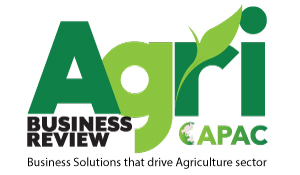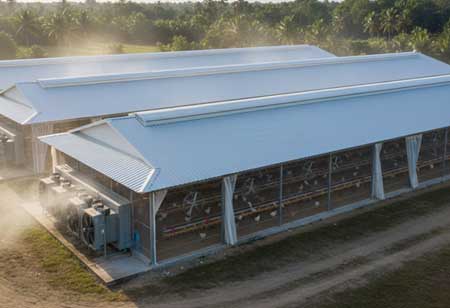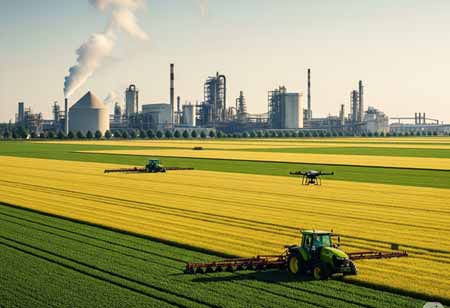Thank you for Subscribing to Agri Business Review Weekly Brief
AI's Role in Optimizing the Soft Commodity Supply Chain
AI and predictive analytics are revolutionizing soft commodity markets by transforming forecasting into a data-driven science, enhancing supply chain stability, efficiency, and transparency for all stakeholders.

By
Agri Business Review | Monday, October 27, 2025
Stay ahead of the industry with exclusive feature stories on the top companies, expert insights and the latest news delivered straight to your inbox. Subscribe today.
Artificial intelligence (AI) and predictive analytics are fundamentally reshaping the soft commodity markets. These technologies convert forecasting from intuitive methods into data-driven science, offering unparalleled insights into agricultural supply, demand, and pricing. This shift is creating a more stable, efficient, and transparent ecosystem for everyone, from farmers to global traders.
For centuries, predicting the prices of soft commodities—agricultural products such as coffee, cocoa, sugar, and grains—presented a complex challenge characterized by a scarcity of comprehensive data. Traditional methodologies relied primarily on a combination of historical data analysis, expert judgment, and rudimentary statistical models. Traders and analysts would meticulously examine past price charts, apply moving averages, and consider seasonal trends to inform their decisions. This quantitative data was complemented by qualitative insights derived from field reports, governmental publications, and personal experience.
While these methods provided a foundational framework, they were subject to significant limitations. Their responsiveness to sudden, high-impact events that frequently affect agricultural markets, such as unexpected pest outbreaks or abrupt shifts in trade policy, was often insufficient. Furthermore, the sheer volume and velocity of contemporary information, ranging from satellite imagery to social media discourse, rendered effective processing by human analysts or simplistic statistical models unfeasible.
The New Forecasting Paradigm: AI's Data-Driven Insight
The AI revolution is ushering in a transformative paradigm driven by advanced machine learning (ML) and deep learning technologies. These systems can ingest and analyze vast, multi-format datasets in real-time, uncovering subtle patterns and correlations that are beyond the reach of human perception. Moving beyond the limitations of examining variables in isolation, predictive analytics models synthesize a comprehensive, multi-dimensional view of markets by integrating data from a diverse range of sources.
Core data streams powering these sophisticated forecasting engines include high-resolution satellite and drone imagery, which provide a global perspective on croplands, enabling precise assessments of crop health, acreage, growth stages, and yield potential. Weather and climate datasets—encompassing historical records, real-time updates, and forecasts—are integrated to capture complex variables such as solar radiation, wind speed, humidity, and soil temperature, allowing for nuanced modeling of environmental impacts on plant development. Ground-level precision is achieved through in-field IoT sensors, which deliver continuous measurements of soil moisture, nutrient content, and localized microclimate conditions, complementing the broader geospatial view. Economic insight is incorporated through the ongoing analysis of market and financial data, including commodity futures, trading volumes, currency fluctuations, and macroeconomic indicators, thereby linking agricultural conditions to broader market dynamics. Advances in Natural Language Processing (NLP) have enabled the processing and interpretation of unstructured data from diverse textual sources, including news articles, government reports, industry publications, and social media content. This capability allows AI to identify early signals of geopolitical disruptions, track the emergence of crop diseases, and monitor shifts in consumer sentiment—factors that can have profound implications for future supply and demand.
How Predictive Models Generate Forecasts
Transforming raw data into an actionable forecast is a structured, multi-stage process. It begins with data ingestion and integration, where information from diverse and often disparate sources is collected, cleaned, and standardized into a consistent, usable format. This is followed by feature engineering, in which the system identifies and selects the most influential variables for the commodity in question. For instance, in the case of coffee, relevant factors may include rainfall patterns in key growing regions such as Colombia and Vietnam, fluctuations in the Brazilian Real, and the availability of shipping containers.
The core stage involves model training, where the AI system is fed years of historical data to learn the intricate relationships between selected features and resulting commodity prices or availability. For example, it may determine how a 2 percent decline in rainfall, combined with a 1 percent increase in global shipping costs, has historically influenced sugar prices three months later. Sophisticated algorithms—such as random forests, gradient boosting machines, and neural networks—are employed to construct predictive models that can capture complex, non-linear dynamics.
Once trained, the model is deployed to generate real-time predictions, continuously analyzing incoming live data streams to forecast supply, demand, and price movements over horizons ranging from several days to several months. These systems are dynamic, leveraging continuous learning to retrain with new data, adapt to evolving market conditions, and enhance predictive accuracy over time.
Transforming the Agri-Market Ecosystem
The advancement in forecasting capabilities holds transformative potential for all stakeholders in the agricultural value chain. For farmers and producers, AI-driven insights empower more informed operational decision-making. Precision yield forecasts tailored to specific fields enable optimized resource allocation and management. At the same time, accurate price predictions support strategic sales planning—whether to sell immediately or store crops in anticipation of more favorable market conditions—thereby maximizing income and mitigating risk. Commodity traders and financial institutions gain a significant competitive edge through predictive analytics, which deliver more reliable price forecasts, identify arbitrage opportunities, and provide early alerts on market-moving developments. This facilitates more sophisticated risk management and the creation of data-driven trading strategies previously unattainable.
For buyers and processors, including large food and beverage manufacturers, such forecasting fosters stronger and more efficient supply chains. By anticipating price volatility and potential disruptions, they can optimize procurement, manage inventories with greater precision, and hedge effectively, ultimately ensuring stable consumer pricing. At the policy level, governments and international organizations can leverage these tools to enhance food security. Accurate national and global yield predictions offer early warnings of potential shortages or surpluses, enabling proactive interventions to stabilize supplies and safeguard vulnerable populations.
AI is fostering a more predictable and transparent agricultural market by integrating diverse data sources, from ground-level observations to satellite imagery. This technological advancement represents not just an incremental enhancement but a profound transformation poised to yield enhanced stability and efficiency within the global food system.





